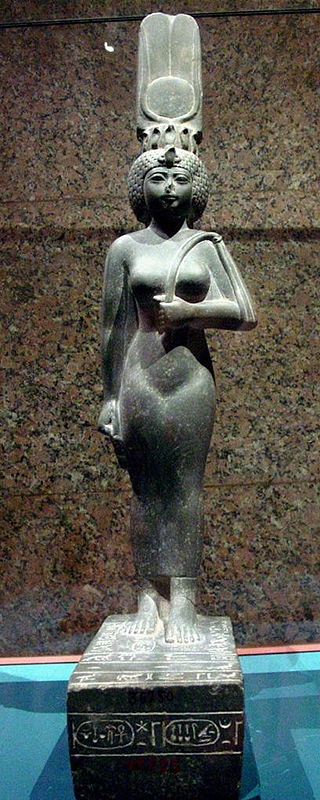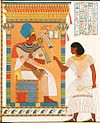
Hatshepsut was the fifth Pharaoh of the Eighteenth Dynasty of Egypt, ruling from c. 1478 or 1479 BC until her death in 1458 BC.

The New Kingdom, also referred to as the Egyptian Empire, is the period in ancient Egyptian history between the sixteenth century BC and the eleventh century BC, covering the Eighteenth, Nineteenth, and Twentieth dynasties of Egypt. Radiocarbon dating places the beginning of the New Kingdom between 1570 BC and 1544 BC. The New Kingdom followed the Second Intermediate Period and was succeeded by the Third Intermediate Period. It was Egypt's most prosperous time and marked the peak of its power.
Peter FitzGerald Dorman is an epigrapher, philologist, and Egyptologist. Recently a professor of history and archaeology at the American University of Beirut (AUB), he served as the 15th President of the university from 2008 to 2015. He spent most of his career as a professor and chair in the department of Near Eastern Languages and Civilizations (NELC) of the University of Chicago, and was director of Chicago House in Luxor, the Epigraphic Survey field project of the Oriental Institute. He is presently a professor emeritus of the University of Chicago.

Amenemhat I, also known as Amenemhet I, was a pharaoh of ancient Egypt and the first king of the Twelfth Dynasty of the Middle Kingdom.

Nubkaure Amenemhat II, also known as Amenemhet II, was the third pharaoh of the 12th Dynasty of ancient Egypt. Although he ruled for at least 35 years, his reign is rather obscure, as well as his family relationships.

Senusret I also anglicized as Sesostris I and Senwosret I, was the second pharaoh of the Twelfth Dynasty of Egypt. He ruled from 1971 BC to 1926 BC, and was one of the most powerful kings of this Dynasty. He was the son of Amenemhat I. Senusret I was known by his prenomen, Kheperkare, which means "the Ka of Re is created." He expanded Egypt that allowed him to rule over an age of prosperity.

God's Wife of Amun was the highest-ranking priestess of the Amun cult, an important religious institution in ancient Egypt. The cult was centered in Thebes in Upper Egypt during the Twenty-fifth and Twenty-sixth dynasties. The office had political importance as well as religious, since the two were closely related in ancient Egypt.

Rekhmire was an ancient Egyptian noble and official of the 18th Dynasty who served as "Governor of the Town" (Thebes) and Vizier during the reigns of Thutmosis III and Amenhotep II, circa 1400 BCE. He was the nephew of Vizier User, who took office at the time of the fifth year of Queen Hatshepsut’s reign. User's official titles included mayor of the city, vizier, and prince. Rekhmire is noted for constructing a lavishly decorated tomb for himself in Sheikh Abd el-Qurna, part of the Theban Necropolis, containing lively, well preserved scenes of daily life during the Egyptian New Kingdom. His tomb is also important as it contains a full copy of a text detailing the duties of the office of the vizier, known as the Installation of the Vizier.
Sennefer or Senneferi was an ancient Egyptian official during the 18th Dynasty.

The Eighteenth Dynasty of Egypt is classified as the first dynasty of the New Kingdom of Egypt, the era in which ancient Egypt achieved the peak of its power. The Eighteenth Dynasty spanned the period from 1550/1549 to 1292 BC. This dynasty is also known as the Thutmosid Dynasty for the four pharaohs named Thutmose.
Tay was a high official of Ancient Egypt with the main title treasurer. He was in office under Hatshepsut and in the first years of Thutmose III. Tay is only known from three attestations. He appears in a rock inscription on the island of Sehel, in a letter that is dated by context under Hatshepsut and from a stela found on Sinai. The latter inscription is dated to year 25 under king Thutmose III. Tay is shown here standing behind the king. According to the rock inscription on Sehel he was on a military campaign with the queen to Nubia. The inscription also provides the throne name Maatkare, of queen Hatshepsut The exact date of the military enterprise is not known for sure, but may have happened in year 12 of the queen. Tay was therefore in office from about year 12 of Hatshepsut till about year 25 under Thutmose III. Under Hatshepsut there is also attested the treasurer Nehsi. Recently it has been suggested, that the office of the royal treasurer was divided into a northern and into a southern office. According to that, Nehesi was the northern treasurer under Hatshepsut, Tay the southern treasurer.
Seni was an ancient Egyptian official with the titles king's son of Kush, overseer of the southern countries and mayor of the southern city (Thebes). He was in office under the kings Thutmosis I and Thutmosis II. As king's son of Kush he was the main official in charge of the Nubian provinces.
Wadjetrenput was an ancient Egyptian official with the title of a high steward. He was in office under the ruling queen Hatshepsut. Wadjetrenput is known from several inscriptions, but none of them is dated, making it hard to provide an exact chronological position for the high official within the reign of the queen. He appears on an ostracon found at Deir el-Bahari also naming the official Senenmut. The latter is well known from the reign of the queen, providing evidence that he also lived in her times. He appears in a rock inscription in southern Egypt, near Aswan. The inscription mentions Hatshepsut and king Thutmose III, providing evidence that the queen sent him on mission to quarry stones. On so called name stones he also appears with the title overseer of works in the Amun temple.
Penre was an ancient Egyptian official of the New Kingdom, in office under the ruling queen Hatshepsut. Penre was viceroy of Kush. The writing of his name varies on the monuments between Penre (Panre), Pare and Payre. Because of his high titles, he was one of the most important officials at the royal court, ruling the Nubian provinces. Kush is the Ancient Egyptian name for Nubia.

Inebny, also called Amenemnekhu was an ancient Egyptian official of the New Kingdom, in office under the ruling queen Hatshepsut of the 18th Dynasty. Inebny/Amenemnekhu was viceroy of Kush, therefore one of the most important officials at the royal court, ruling the Nubian provinces. Inebny/Amenemnekhu is first attested in year 18 of the queen; a further dated inscription belongs to year 20, while around year 22/23 a certain Nehi was appointed to become viceroy of Kush. Inebny/Amenemnekhu bears two names.
Djehuty was an ancient Egyptian official under the ruling queen Hatshepsut. He bore several important titles that testify his high position at the royal court. His main title was overseer of the silver and gold houses. With this title he was the main person in charge of the treasury at the royal palace. He is attested from year 9 to year 16 of queen Hatshepsut. In year 9 he was involved in the queen's expedition to the foreign land called Punt in Egyptian sources. In year 16 he was inlaying the gold for the obelisks of the queen, that were set up in this year. He was buried in a Theban tomb (TT11). From his tomb are preserved two stelae, one of them with a longer autobiographical inscription reporting mainly building activities in Amun temple at Karnak. At the end of his career Djehuty and his family felt into dishonor. His name is most often erased within his tomb. His parents are the lady of the house Dediu and the zab Abty. The names of the parents are erased too, as are the names of other family members.
Amenhotep was an ancient Egyptian high steward in office during the reign of Queen Hatshepsut. He is mainly known from his tomb and from a series of rock-cut inscriptions in the Aswan region.
Senimen was an ancient Egyptian official who lived at the beginning of the 18th Dynasty and who was tutor of the king's daughter Neferure. The latter had an exceptionally high status under the ruling queen Hatshepsut.
Sememiah was a high ancient Egyptian official of the 18th Dynasty in office under the ruling queen Hatshepsut. His main title was that of an Overseer of the treasuries.
Minmose was an Ancient Egyptian official under the ruling queen Hatshepsut. He was the overseer of the double granary. He is shown in the queen's mortuary temple at Deir el Bahari in a scene depicting the transport of two obelisks. and was therefore evidently involved in the erection of these monuments. He also appears on objects found in the burial KV60 of the nurse Sitre In who was buried in the Valley of the Kings. Minmose might have been buried close the temple of Hatshepsut at Deir el Bahari. There was found a burial in shaft tomb with the remains of a coffin belonging to a person called Minmose. The burial was already heavily looted in ancient times and reused in the 21st Dynasty.









